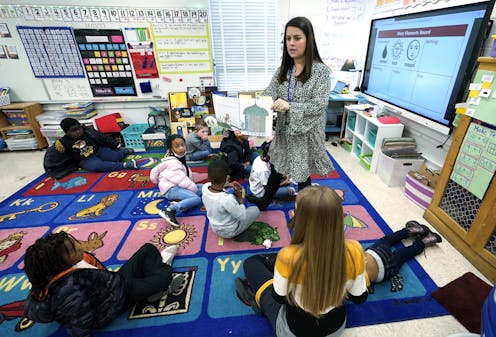
The Research Brief is a short take about interesting academic work.
The big idea
U.S. elementary school students do not particularly benefit from being taught by teachers of the same race or ethnicity. That’s the major finding from our new study, published in Early Childhood Research Quarterly. We analyzed a nationally representative sample followed from the start of kindergarten to the end of fifth grade.
Our findings indicate that calls to diversify the teacher workforce are unlikely to meaningfully address large racial and ethnic educational inequities in U.S. elementary schools.
We compared the academic achievement, classroom behavior and executive functioning of U.S. elementary school students across two naturally occurring conditions.
The first condition was when students were in grades taught by teachers of the same race or ethnicity. The second condition was when the same students were in grades taught by teachers whose race or ethnicity differed. We also controlled for other factors including a student’s age, their family’s economic resources and the teacher’s level of education and years of experience.
We analyzed data from three individually administered tests of academic achievement, five teacher ratings of classroom behavior and two independently assessed executive functioning tasks. We also examined whether students were placed in either gifted or special education classes.
Overall, we observed that being taught by teachers of the same race or ethnicity made little difference in whether students displayed greater achievement, better behavior or increased executive functioning or were more likely to be in gifted or special education classes. We occasionally observed positive as well as negative effects. Yet these effects were inconsistent and small in size.
Why it matters
Educational inequities including those in achievement occur as early as kindergarten and continue throughout elementary school. One common suggestion to address these inequities has been to increase the frequency that Black and Hispanic students are taught by teachers of the same race or ethnicity.
It is possible, for instance, that being taught by a teacher of the same race or ethnicity might help lessen biases and cultural misunderstandings, increase access to role models and mentors, and foster student engagement in classroom activities. Rigorous studies repeatedly find that students of color, particularly those who are Black, benefit from being taught by teachers of the same race or ethnicity.
Yet the observed effects are often quite small and more often observed on subjective measures like classroom behavior than on objective measures of academic achievement. This is consistent with what we observed.
Our results also are consistent with other studies analyzing nationally representative samples that find student-teacher racial or ethnic matching has only limited benefits for students of color.
It may instead be that being taught by teachers of the same race or ethnicity is particularly beneficial in specific regional contexts. For instance, in the U.S. South, this may occur because of the region’s history of segregation and discriminatory practices. Most of the benefits of student-teacher racial matching have been observed in studies analyzing samples of students attending schools in the U.S. South.
What still isn’t known
Although we analyzed a nationally representative sample and examined for treatment effects across many student groups, our study has several limitations. The data was collected only for elementary school students. The experiences and performance of U.S. middle and high school students may differ.
It is also possible that matching’s positive effects begin to emerge as students enter adulthood. For example, recent work finds that Black students taught by Black teachers are more likely to graduate from high school and enter college, particularly two-year colleges.
Long-term studies are needed that evaluate matching’s benefits. Additional studies are also needed of the potential benefits for students attending schools in the U.S. South. Preliminary work finds that matching’s effects may be specific to whether teachers attended historically black colleges and universities, regardless of their race or ethnicity.
Paul L. Morgan receives funding from the U.S. Department of Education's Institute of Education Sciences, the National Science Foundation, and the National Institute of Child Health and Human Development.
Eric Hengyu Yu does not work for, consult, own shares in or receive funding from any company or organisation that would benefit from this article, and has disclosed no relevant affiliations beyond their academic appointment.
This article was originally published on The Conversation. Read the original article.







